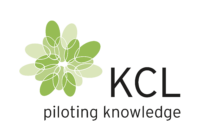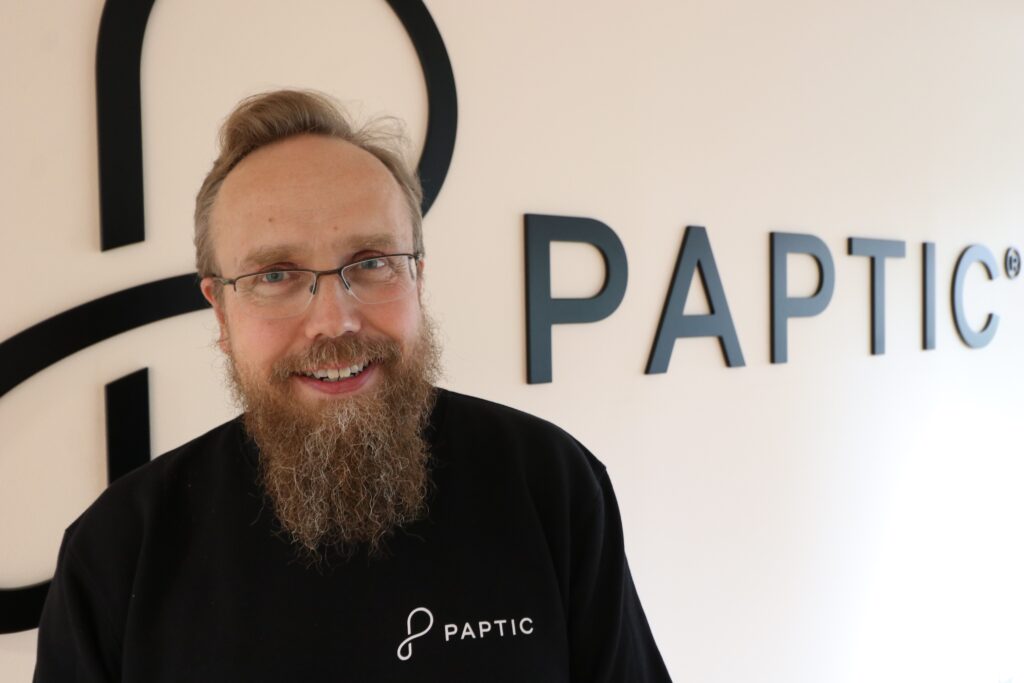The world is drowning in plastic packaging and traditional paper does not fit everything. Fortunately, Paptic developed a wood-fibre based and recyclable at scale packaging material that combines the best aspects of plastic and paper. Now Paptic can be found both in the bags of ordinary department stores and in the electronics packaging.
In the world of startups, we are used to the fact that after the initial buzz, a large part of the companies remain just promises. Paptic is a happy statistical exception: It has started to deliver on its promises. For four years in a row, Paptic has doubled its turnover every year. In 2022, the company’s turnover was 11 million euros. And the growth continues. In September 2023, Paptic secured 23 million additional funding for its operations. New capital investors are the German capital investment fund European Circular Bioeconomy Fund (ECBF) and the global water, hygiene, and infection prevention company Ecolab.
Founded in 2015, Paptic has been successful in its funding rounds before – that’s why its growth potential is interesting in the eyes of investors. There is also a crowdfunding round behind, thanks to which the company has around 750 owners.
One hundred billion plastic bags
Around the time the company was founded, in the mid 2010s, 100 billion plastic bags were used annually in Europe alone. The number was only predicted to rise. There was even speculation that the EU would ban plastic bags. In the end, there was no total ban, but the EU set various recommendations and ever-tightening recycling requirements.
However, in recent years, around 100 countries have restricted the use of thin, single-use plastic bags in particular. For example, in Kenya, manufacturing plastic bags can result in a four-year prison sentence or a fine of 36,000 euros. In Europe, 18 countries have already banned thin plastic bags, including France, Germany, Italy, Iceland and Albania. Awareness of microplastics and plastic pollution drifting into the seas has increased dramatically. So, the world has become much more favorable for Paptic, whose sustainable materials are based on renewable wood. Bags made of Paptic® can be recycled in a cardboard stream and the collected high-quality fibres can be used for example in cardboard production.
From Patents To A Growth Company
Esa Torniainen and Paptic’s other founder, Tuomas Mustonen, shared a background from M-Real to KCL and VTT Technical Research Centre of Finland. At some point during their time at VTT, they noticed that all customers in the forestry sector seemed to be asking about innovations that could replace plastics.
Thanks to their occupational background, Torniainen and Mustonen knew that nearly anything could be done with wood fiber. Then why wasn’t it – replacing plastics – done already? “When you develop something new, it is rarely cheaper than what is on the market. And not cheaper than what it is replacing,” pondered Paptic’s Esa Torniainen. “But there was and is clearly a demand on the market for products that replace plastic. We concluded that precisely flexible packaging is an interesting, growing market.”
Flexible packaging refers to packaging where the packaging takes the shape of the item. A drink bottle isn’t like that, but a pouch of pasta is. The flexible packaging market is currently estimated to be more than 200 billion euros annually worldwide, and 70% of the materials used are plastics. In almost half of the end uses, plastic could be replaced with Paptic® materials.
But let’s go back to the stages before the company was founded. VTT’s competence portfolio had numerous routes to replace the plastic bag. The only problem was their industrial applicability. “Then we found an innovation that we could use in paper machines, as long as foam was used in production instead of water. The technique is called foam forming,” said Torniainen. Based on their working careers, he and Mustonen thought that the innovation’s momentum would pass if they started to propose it to the slow-reacting large packaging material giants. “The idea was born that we would do it ourselves. At VTT, you were encouraged to become an entrepreneur,” Torniainen recalled.
Enthusiastic first reception
“We knew that the new product wouldn’t be sold with PowerPoint shows. So, we opened discussions with KCL so that we could test the innovation,” said Torniainen. Although a paper machine could be used in the production of the new product with only minor modifications.
“KCL is not a One Trick Pony. We have had many different types of cooperation with them. KCL can offer almost everything related to the development of novel biomaterials,” Torniainen stated. “The company has a long, long history and there is a lot of brilliant know-how throughout the organization.”
In addition, with KCL’s equipment, it is possible to demonstrate the functionality of the technology, to simulate industrial-scale production. With KCL, you can go through the entire chain with many products, from raw material processing to the final product, thanked Torniainen.
After a couple of test production rounds with KCL, the gentlemen had a few sheets from which they cut and glued samples for potential customers in Finland, Germany, Sweden, and the UK. “The customers loved our product. They wanted to order bags right away at our first meeting. We concluded that the concept works. Then, we were in a hurry to get production up to speed.”
The first funding round was quickly successful. After all, Paptic had an understandable concept and already willing customers: The company manufactured a new, recyclable material made of wood, which replaces plastic. It is used to make bags or product packaging, even fruit bags.
“In the beginning, we profiled ourselves as a bag company. Thirteen months after the company was founded, we had Paptic bags in all stores of the Finnish clothing store Seppälä”, recalled Torniainen.
Torniainen reminded, that Paptic only manufactures packaging material. Our customers make bags and packaging. “We are just another boring material producer,” he grinned.
A winning bag of onions
Paptic’s ideology is to replace plastics, not paper. “For us, paper is a bit like a country cousin – good for less demanding packaging. Paptic is suitable for more demanding applications where plastic has been used until now,” describes Torniainen. As a packaging material, the advantage of Paptic is that it can be run on the same packaging machines – and at the same speeds – as plastics. Machine speeds must be slowed down with papers. “Factories where products are packaged rarely have extra capacity in the packaging facilities,” explained Torniainen. -The innovative material’s advantage is also its lightness, which is not only a cost factor but also an environmental issue.
With Paptic, you can’t get a transparent clear material, but the thinnest product versions allow you to, for example, read the barcode or see the product’s surface pattern thanks to the translucency. Paptic also breathes, although insulates, too. For example, in Paptic’s World Star award-winning onion bag that replaced plastic, the onion lasts longer according to the brand.
One bag manufacturer promises that the Paptic bag can hold 35 kilos, while paper can hold only around 15 kilos. When a paper bag gets a small cut, the bag is unusable. The one made of Paptic can still be used. Plastic bags, on the other hand, are seldomly reused. “Thick paper and plastic bags are difficult to reuse. The fabric-like Paptic bag that folds into a pocket is not,” described Torniainen.
One packaging material that competes with Paptic is, for example, polyethylenes made from corn or other renewable, non-fossil raw materials, which end product is exactly the same plastic as fossil ones. Its advantage is that the raw material is no longer a source of carbon emissions pumped from the soil. But bio-PE breaks down in nature just as badly as regular PE, i.e., plastic. “If our Paptic product gets in the wrong place, it gets lost there, it lands like paper.”
The way to a fast and flexible growth
But which production method would enable rapid growth? For example, the flexible packaging market was around 30 million tons in 2021. It is still the fastest growing packaging segment. And the fastest growing sub-segment there is sustainable packaging materials – Paptic’s own field. The paper packaging market, on the other hand, is not growing.
“We thought, how do we take this to a bigger scale? Licensing? Contract manufacturing? Shall we buy our own machine? Shall we build our own machine? We ended up with contract manufacturing,” said Torniainen. Now there are several manufacturing partners. “Paptic is still actively looking for partners from contract manufacturers to broaden our material selection”, he advised.
The company’s home market is currently Europe. “With the exception of Antarctica, we have delivered Paptic to all continents,” said Torniainen. The USA, China and India are already on its list of the over 50 export countries. But if Paptic is serious about entering a large market like the US, its own presence is essential.
“We want to build Paptic into a really big thing, where we can serve global brands and packaging manufacturers.”
One of its owners, the large Japanese trading house Itochu, has been a gate opener for Paptic in Asia. It also sells and markets Paptic materials, also in Japan. Moomin Characters, a popular operator in Japan, also has a stake in Paptic. “Japan is a traditional paper-using country, a traditional overpacking country, where environmental issues are also increasingly important,” Torniainen reminded of the company’s market potential in the Far East.
750MEUR Revenue by 2030
It is good to set the goals of a growing company high enough to maintain the hunger for growth. When asked, Torniainen sets Paptic’s growth goal for the year 2030 – reach 750MEUR revenue by then. “At that time, we will be operating in a significantly wider market than now. We have brought even more competitive products to the market. Our market share in the entire packaging industry may still not be large, but fortunately, our market itself is growing,” said Torniainen.
A quickly scalable production model that enables fast growth and works at reasonable costs. “Not only can we use the existing paper machines, when the necessary changes are made to them. But that paper machine is a microscopically small piece of this scalability pattern,” described Torniainen. “Of course, we can use the existing machine– but also everything else that is around the machine. For example, the already existing supply of raw materials, because we use largely the same raw materials as the paper mill.” The slow and expensive rebuilding of factories, roads, and railways is therefore not needed. “So, our route to the market is much faster than building a completely new manufacturing capacity.”
One thing is bothering Torniainen, like so many other technology company leaders with a desire to grow: a shortage of talent. “We are constantly looking for experts in the packaging industry, above all in the flexible packaging side,” advises Torniainen.
In addition to international growth, Torniainen also has more mundane sales goals. “Wouldn’t it be great if the bags of candy you eat in the cinema didn’t rustle,” he asked. Unlike paper bags of candy buffets or plastic candy wrappers currently in use, Paptic does not rustle.
Text and photo: Jan Erola

